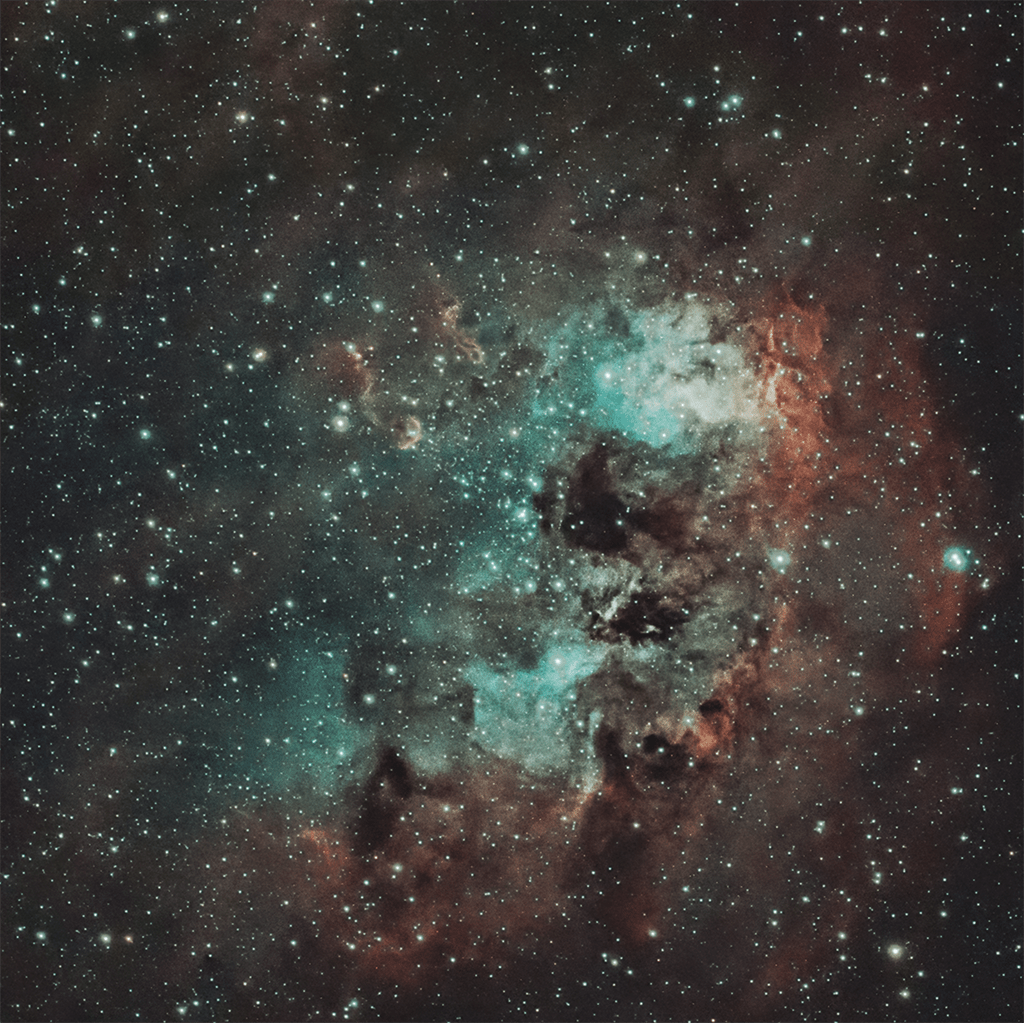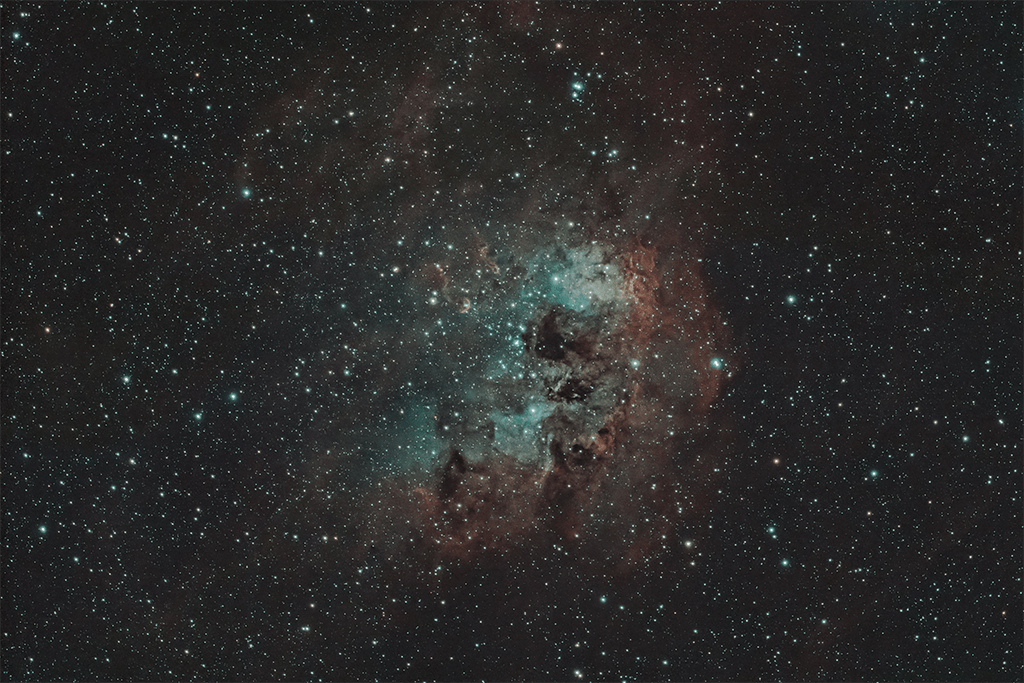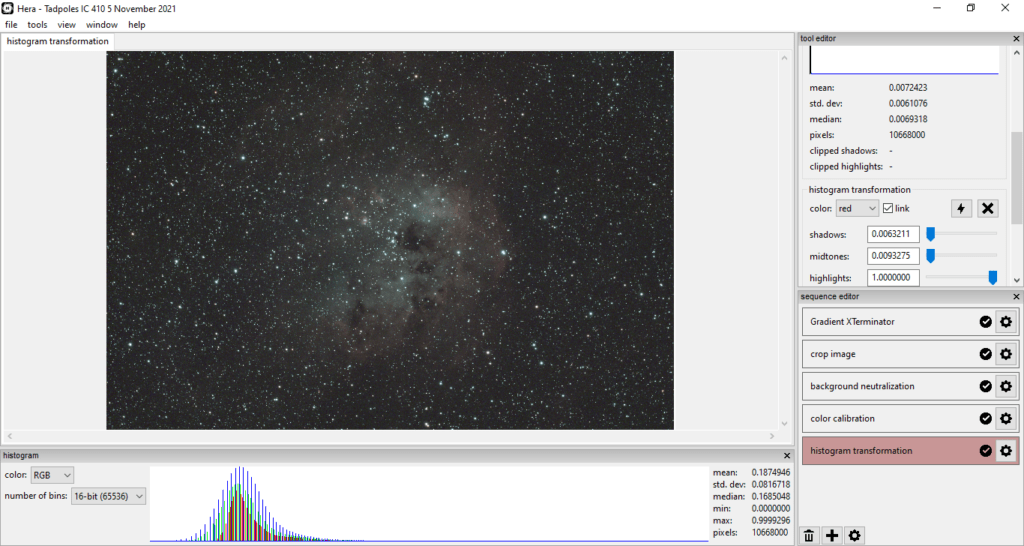This is the Tadpoles Nebula, a first-time target for me. We’re looking at a star cluster embedded in an ionised Hydrogen (HII) region. To the top-left of centre, you can see the tadpoles. They trail away from the central star cluster, with their heads outined by ionised gas. They are quite clear in the cropped version below. Their striking shapes were formed by the star cluster’s stellar winds and radiation.
Hera image processing
I’ve had several months of cloudy nights (since 7 September). There’s been the odd break in the cloud here and there, usually with a full moon out, but nothing worth setting up for. So with astrophotography out of the question, I’ve been busy working on something I’m finding nearly as compelling… developing some powerful new astrophotography processing software, called Hera.
The principles of Hera are to:
- offer a range of basic processing tools
- as well as some of the latest cutting-edge ones from the scientific literature;
- have a fully-editable and re-computable process history;
- be fast;
- not save large intermediate images, and instead only the ‘sequence’ of steps that gets you to the final processed image (so that means small files);
- have a user-friendly interface.
The screenshot below shows the Tadpoles Nebula during an early stage of processing, just after colour calibration and initial stretches. Obviously, the software is not finished, or even near ‘release’ yet, so I finished this image in Photoshop.
Tools
I used Gradient XTerminator in processing this image, but I’ve got my own background removal tool in development to replace it. There are various other powerful tools in development including: À trous wavelet decomposition (basically finished), and a few varieties of denoising algorithms (including non-local means, which is simple, effective but slow; DCT, which is simple, fast and represents a baseline performance for other algorithms; and the more advanced anisotropic diffusion; not to mention, using wavelets decomposition to suppress the noise scales which is already available).
All this takes time, and I usually spend 2–3 hours on it on a couple of evenings per week. I’m working on my own, so development is quite slow, although I do think I’ve achieved a lot since I started work on it in August 2021. It’s the interface that takes longest to code, believe it or not! In addition to the powerful features mentioned above, I will of course eventually include all the basics, including things like masks and star reduction (which are next on the list after finishing the background removal and wavelet decomposition tools).
Technical details
Hera is all written in C++. The graphical user interface (GUI) is written in wxWidgets, which means it is cross-compilable for Mac OS X and for Linux/Unix. Image handling is in OpenCV, which helpfully provides some useful algorithms, but not as many as you’d think for this kind of work! 32-bit floating point representation is used throughout.
Public release
I’m thinking, if there seems to be enough interest, I will offer a basic version for free, and also sell licenses for the full version, probably on an inexpensive annual subscription basis (much like SharpCap). That’s certainly quite a way off, as I need a more extensive suite of tools, plenty of testing, and I will need to write documentation, record demo videos, etc. because otherwise, it’s all for nothing! If you are interested in this project, and want to be kept up-to-date, or you are interested in possibly helping with testing at some point in the future, leave a message below.
Image details
Frames
- 57× 150-s light frames (Gain 900) from 72 overall (best 80%)
- 2 h 22 min 30 s total exposure time
- Full use of calibration frames (darks, flats, dark flats)
Equipment
- Explore Scientific ED 102 mm Apo f/7 refractor
- Revelation Adjustable Field Flattener
- Sky-Watcher EQ6-R PRO SynScan GOTO equatorial mount
- Altair Hypercam 294C PRO colour fan-cooled camera
- Altair quad-band one-shot colour (OSC) 2″ filter
- Pegasus FocusCube v2
- Altair 60mm guide scope
- Altair GPCAM2 AR0130 mono guide camera
- Hystou Rugged Fanless Mini PC i5 7260U
Software
- SharpCap 4.0
- PHD2
- DeepSkyStacker
- Gradient XTerminator
- Hera 0.1.0
- Photoshop
- Topaz DeNoise AI





Great images, would love to keep up with the Hera project.
Definitely interested in helping with testing and having a look, I love to get on board with new software. Looking forward to seeing how this progresses.
All the best,
Stacey
Thanks both.
Greg, I’ll keep posting Hera updates here on my blog.
Stacey, it would be great to have you on-board as a tester. Thank you. I’m happy to let you experiment with what’s currently available, that’s if using an incomplete toolset wouldn’t be too frustrating! I haven’t quite decided at what stage I will move to version 0.2, and release it for wider testing. I think it’s probably important to have most of the essential features in place for a full process in Hera first, so it can be considered a ‘serious player’ from the get go, but I guess that’s still a few months off.
Ah not at all! I like to have a play, but either way let me know when you’re looking for some extra testing. I’m a big fan of making astrophotography processing more accessible to more folks. Some of the current software out there is wonderful, but with a huge huge learning curve !